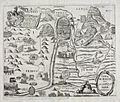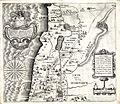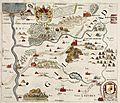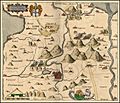Thomas Fuller facts for kids
Quick facts for kids
Thomas Fuller
|
|
|---|---|
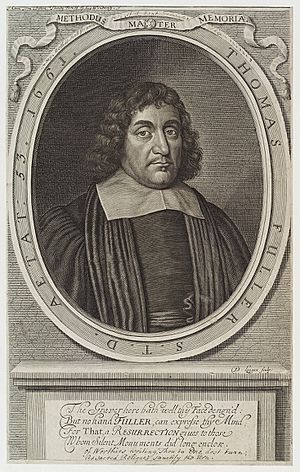 |
|
| Born | 1608 Aldwinkle St Peter's, Northamptonshire, England
|
| Died | 16 August 1661 (aged 52–53) Covent Garden, London, England
|
| Alma mater | University of Cambridge |
| Occupation | Clergyman and historian |
| Known for | Worthies of England |
Thomas Fuller (born 1608, died 1661) was an English churchman and historian. He is best known today for his many writings. His most famous book, Worthies of England, was published in 1662, after he passed away. Thomas Fuller wrote so much that he was one of the first English writers who could earn a living just from his writing.
Contents
Early Life and Education
Thomas Fuller was born in 1608 in Aldwinkle St Peter's, Northamptonshire. He was the oldest son of Thomas Fuller, who was a rector (a type of church leader) in the same village. His uncle and godfather was Dr. John Davenant, a bishop of Salisbury. People said that young Thomas was very clever.
When he was just thirteen, Thomas went to Queens' College, Cambridge. His uncle, John Davenant, was in charge of the college at that time. Thomas did very well in his studies. He earned his first degree (B.A.) in 1625 and his master's degree (M.A.) in 1628, when he was only 20 years old.
After not being chosen for a special position at Queens' College, he moved to Sidney Sussex College, Cambridge in 1628. In 1630, he became a curate (a church assistant) at St Bene't's Church in Cambridge.
Fuller's Early Career
Thomas Fuller was a great speaker, and his sermons quickly became popular. In 1631, his uncle gave him a special role as a prebend in Salisbury. His father also worked there. In 1634, he became the rector of Broadwindsor, a church in Dorset.
In 1635, he earned another degree, a Bachelor of Divinity, from Sidney Sussex College. In 1640, he was chosen to represent Bristol in a big church meeting called the Convocation of Canterbury. This meeting happened at the same time as the Short Parliament, a short-lived government assembly. Fuller wrote a detailed report about this church meeting in his book, Church History.
Life During the Civil War
The English Civil War began in 1642. Thomas Fuller lived in Broadwindsor at the start of the war. He and others in his parish signed a paper showing their loyalty to Parliament. Even though he wasn't officially removed from his church roles, he left them around this time.
Fuller then became a popular preacher in London. He preached at the Savoy Chapel, where many people came to hear him. He often spoke about peace and tried to encourage people to find a way to end the fighting between the King and Parliament.
Fuller's Troubles and Travels
In 1643, Fuller was asked to take a petition (a formal request) to the King, Charles I, who was in Oxford. However, on his way, soldiers from the Parliament's army stopped him and his group. They found some "scandalous books" and letters on them. Fuller and his friends were briefly put in prison.
When peace talks were expected, Fuller preached a sermon at Westminster Abbey in 1643. He spoke about the King returning in peace. Later, he preached about church changes, saying that only the highest power (the King) could make such reforms.
Because of his views, Fuller had to leave London. He joined the King's side in Oxford in August 1643. He became a chaplain (a religious leader) for Sir Ralph Hopton's army. Fuller's calm and moderate preaching style sometimes upset the more extreme royalists.
After a battle, Fuller went to Basing House, a place that was under attack. He helped defend it. His time with the soldiers led people to see him as one of the "great cavalier parsons" (a royalist clergyman).
In 1645, while in the besieged city of Exeter, he wrote a small book of prayers called Good Thoughts in Bad Times. He called it "the first fruits of Exeter press." He was a chaplain to Princess Henrietta Anne, who was a baby at the time.
After Exeter surrendered to Parliament, Fuller made an agreement with the government. He was considered a "delinquent" because he had been with the King's forces. He wrote a book called Andronicus, or the Unfortunate Politician (1646), which made fun of the leaders of the Revolution. To help people suffering from the war, he wrote another book of prayers, Good Thoughts in Worse Times (1647). He also wrote Cause and Cure of a Wounded Conscience (1647) because he was sad about losing his library and manuscripts.
For a few years, Fuller mostly earned money by working with booksellers. He also started translating a book by his friend, Archbishop Ussher.
Life Under the Commonwealth
After the Civil War, England was ruled by Parliament, a period known as the Commonwealth. Thomas Fuller continued to preach. In 1647, he started preaching as a lecturer at St Clement's, Eastcheap in London. He was briefly stopped from preaching but soon got his freedom back.
He became a chaplain to James Hay, 2nd Earl of Carlisle, who helped him get the curacy of Waltham Abbey Church around 1648 or 1649. Even when Oliver Cromwell's government tried to stop royalist supporters from preaching in 1655, Fuller managed to keep his position at Waltham.
Fuller was likely in the Netherlands just before King Charles II returned to England. He was with John Berkeley, 1st Baron Berkeley of Stratton, who helped Fuller try to become a bishop. Fuller wrote a poem celebrating the return of King Charles II.
After the Restoration
When King Charles II returned to the throne in 1660, Thomas Fuller was given the title of Doctor of Divinity by Cambridge. He continued his popular lectures at the Savoy Chapel. Samuel Pepys, a famous diarist, heard him preach but preferred Fuller's conversations or his books. Fuller's last important role was as a special chaplain to King Charles II.
Death

In the summer of 1661, Thomas Fuller traveled for his church duties. On August 12, while preaching at the Savoy, he became very sick with typhus fever. He died on August 16, 1661, at his home in Covent Garden, London.
He was buried in St Dunstan's Church in Cranford, where he was also the rector. A special plaque was put up in the church. It says that while he tried to make others famous in his book Worthies, he became famous himself.
Fuller's Important Writings
Thomas Fuller wrote many books and sermons. Here are some of his most well-known works:
- David's Heinous Sinne, Heartie Repentance, Heavie Punishment (1631): This was a poem about the biblical story of David and Bathsheba.
- The Historie of the Holy Warre (1639): This book tells the story of the Crusades, which were religious wars from 70 AD to 1290. It includes his thoughts, a timeline, and a list of sources.
- Joseph's party-coloured Coat (1640): This was his first collection of sermons.
- The Holy State and the Prophane State (1642): This popular book describes how people should live a good life in their families and in public. It gives rules for behavior and examples of different jobs.
- A Pisgah-Sight of Palestine and the confines thereof (1650): This book describes the geography of the Holy Land. It includes interesting maps and pictures.
- Abel Redevivus (1651): This book contains the lives and deaths of many religious leaders.
- Church-History of Britain (1655): This book covers the history of the church in Britain from the birth of Jesus until 1648. It also included histories of the University of Cambridge and Waltham Abbey.
- Notes upon Jonah (1657).
- History of the Worthies of England (1662): This is Fuller's most famous work. It was published after he died.
A Pisgah-Sight of Palestine – Gallery
Family Life
Around 1640, Thomas Fuller married Eleanor Grove. She passed away in 1641. Their son, John, was born in 1641. John later helped publish his father's Worthies of England in 1662.
Around 1652, Fuller married his second wife, Mary Roper. They had several children together.
See also
 In Spanish: Thomas Fuller para niños
In Spanish: Thomas Fuller para niños



